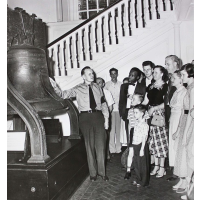Americans’ Visits to Historic Sites in Decline
 Tourists view Liberty Bell in Philadelphia, 1951 (photo: Independence National Historic Park Library & Archive)
Tourists view Liberty Bell in Philadelphia, 1951 (photo: Independence National Historic Park Library & Archive)
By Humanities Indicators, American Academy of Arts & Sciences
In addition to using libraries and visiting museums, historic site visitation is another common form of public engagement with the humanities. The percentage of people reporting at least one such visit in the previous year fell by more than a third from 1982 to 2012, with declines across most age groups.
FINDINGS AND TRENDS
In 2012, 24% of Americans age 18 or older had visited a historic site in the previous year. This was 13 percentage points lower than in 1982, with the bulk of the decline occurring from 2002 to 2012.
The decline in historic site visitation from 1982 to 2012 was largest in the 25-to-44-year-old population, an age group that includes many parents of young and adolescent children. However, because no reliable national data on children’s visits to historic sites currently exist, establishing whether a corresponding decline occurred in the percentage of children who visited historic sites is not possible.
Over the 30-year period studied here, the differences among age groups with respect to rates of historic site visitation substantially decreased. For example, in 1982, the rate of visitation among 25-to-34-year-olds (the group most likely to visit a historic site in that survey) was approximately 11 percentage points higher than that of the youngest age group (18-to-24-year-olds), and more than 17 points higher than that of people ages 65–74. By 2012, however, the visitation rates of 25-to-34-year-olds had dropped to within five percentage points of the younger cohort and fell slightly behind the rate for the older cohort. In 2012, the age group most likely to have visited a historic site was 55-to-64-year-olds, but their visitation rate was only six percentage points higher than that of 18-to-24-year-olds, the group least likely to visit.
The data reveal generational differences with respect to Americans’ tendency to visit historic sites. With each birth cohort, Americans of all ages have been less likely to visit historic sites. For example, those born from 1938 to 1947 had a 45% likelihood of having visited a historic site in the previous 12 months when they were ages 35–44, while those who were born in the 1968–1977 period had only a 23% likelihood of having visited a historic site when they were the same age.
As people aged they were less likely to visit a historic site. In each of the three cohorts for which the most complete data are available, the drop-off in historic site visitation over the life course is at least 25%.
To Learn More:
Public Outcry over Renaming of Yosemite Landmarks in Trademark Dispute (by Dan Whitcomb, Reuters)
Volunteers Scramble to Protect Closed State Parks (by Noel Brinkerhoff, AllGov)
National Park Fees Increased for First Time in 9 Years (by Noel Brinkerhoff, AllGov)
Report Faults National Park Service for Not Supporting History Education (by Noel Brinkerhoff and David Wallechinsky, AllGov)
- Top Stories
- Unusual News
- Where is the Money Going?
- Controversies
- U.S. and the World
- Appointments and Resignations
- Latest News
- Trump to Stop Deportations If…
- Trump Denounces World Series
- What If China Invaded the United States?
- Donald Trump Has a Mental Health Problem and It Has a Name
- Trump Goes on Renaming Frenzy






Comments